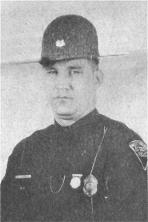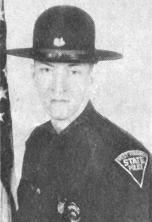
Litton
1935

Sites
1942

Swartz
1970

Shrewsbury
1978

Hacker
1993
|
Hall Remembers State Troopers
From behind framed glass, the youthful eyes of Trooper First
Class Larry G. Hacker now watch passersby walk through the West Virginia State
Police Hall of Honor.
Hacker's black-and-white portrait is positioned last in a row of 35 state
police officers who have made the ultimate sacrifice - dying in the line of
duty.
Individuals walking through the Hall of Honor at state police headquarters in
South Charleston can feel the powerful presence and the incredible stories of
the 35 individuals who have died protecting West Virginia citizens.
In all cases, there is a story - a tragic situation that cost at least one
life. Troopers were killed in ambushes and accidents, while performing
everyday duties, in shootouts, and as bystanders.
Regardless, they were killed trying to protect society.
The State Police Hall of Honor was erected in 1990 to recognize those officers
who died.
According to former State Police Superintendent Col. Jack Buckelew, records
and photographs of these fallen individuals were always kept at the West
Virginia State Police Academy archives.
"It was nice, but it didn't project the honor," Buckelew said.
The Hall of Honor is a 30-foot long hallway with rich brown wooded walls. The
troopers' 8x10 portraits line either side at eye-level. The row of photographs
breaks in the center where the state seal and copies of the Bill of Rights and
the U.S. Constitution hang on the wall. The American flag, the state police
flag and a small podium stand before the state seal.
Upon the podium rests a book filled with stories of valor, detailing - as much
as possible - the situation surrounding each officer's death.
Buckelew said the Hall captures passersby. "It makes people realize what
they sacrificed for them."
Five state police officers killed in the line of duty were members of area
detachments. All officers had tragic stories behind their deaths.
Trooper First Class Larry G. Hacker, 34, was the latest state police officer
to die. He died April
8, 1993. Hacker was a member of the Ritchie County detachment and had been
with the police force for four years.
Hacker and other law enforcement officers, were responding to a domestic
violence complaint involving neighbors in rural Ritchie County.
Hacker and fellow officer, Trooper SJ. Verdow, were examining the area in
dispute. Hacker apparently peered around the corner of a shed and was shot.
Dennis R. Ferguson, 67, held
other officers at bay while brandishing his weapon. He then ran to the woods
and began firing at officers, preventing them from assisting Hacker.
Finally, Hacker was flown from the area and later died at Camden-Clark
Memorial Hospital. Ferguson was charged with one count of aggravated murder.
Hacker, in effect, was ambushed, Buckelew said.
Cpl. Dewey Shrewsbury, 39, died Oct. 8, 1978. According to state police
history, Shrewsbury, a 16-year veteran of the state police, died at his home
in Elizabeth from an apparent accidental gunshot wound.
Shrewsbury
may have just finished cleaning his weapon, had reloaded and accidentally shot
himself, Buckelew said. Buckelew speculated the trooper may have been
dry-firing and forgot the gun was loaded.
Trooper Hugh Donald Swartz, 37, died Oct. 5, 1970. Swartz, a 12-year veteran
of the state police, died of a gunshot wound in the throat. He was attempting
to serve a warrant to Ray Miller in Clay County. Miller was arrested and
convicted of the shooting.
Sgt. Newton Tressel Sites, 54, died in an airplane crash on Aug. 31, 1942.
Sites was flying a "blackout" over the Wood County area, according
to Buckelew. A "blackout" was a civil defense operation during World
War II in which everyone extinguished their lights and pulled curtains to
avoid being spotted by enemy planes. Sites was flying to ascertain everyone
was obeying the "blackout" As the plane was about to land, the woman
pilot's high-heeled shoes became snagged on the mats in the plane. The plane
crashed and Sites died.
Trooper Farley K. Litton, 25, died Nov. 8, 1935 in an motorcycle-automobile
accident near Sistersville. Litton was
operating a motorcycle and was on his way to an accident. He rounded a sharp
curve and an automobile on the wrong side of the road collided with him.
All of the deaths had a tragic story to them.
For instance, Trooper H. G. Lucas Jr. died in a State Police helicopter crash.
The helicopter was transporting a patient to a hospital. "The only reason
he flew was to save a life," said State Police Superintendent Col. Thomas
Kirk, who was a friend of Lucas. "He was trying to help and ended up
getting killed.
Another of Kirk's friends, Trooper First Class J. T. Brammer, was killed while
attempting to serve a warrant in Preston County. Trooper First Class R. J.
Hicks was injured in the same incident.
~Hicks was able to crawl to a neighbor's house in an attempt to get
help," Kirk said. "The woman wouldn't let him in because she didn't
want him to get blood on her carpet."
The woman did get an extension line for the telephone and let the officer use
it, Kirk said.
Many of the fatal incidents occurred while officers were performing the
seemingly safer tasks of law enforcement. However, these can prove most deadly
because the officer doesn't expect anything to go wrong, Kirk said. As
an example, two state police troopers were killed in Paw Paw while trying to
arrest a man in a domestic violence dispute.
Larry Parker shot and killed Trooper First Claus T. D. Hercules and Trooper
Charles Henry Johnson, both of the Berkeley Springs detachment.
"Domestic violence situations and traffic stops are becoming more and
more dangerous," Kirk said. "Times are tougher, family matters are
strained and emotions are running high," Kirk said was the reason
domestic calls are becoming more deadly.
"Also drugs and the fact that the stats is now becoming a source for
firearms for people are making traffic stops more dangerous."
Kirk said bulletproof vests and proper communications equipment would help
dramatically in dangerous situations.
There are about 500 state troopers and only a handful have bulletproof vests -
which they purchased for themselves, Kirk said. A good vest would cost about
$500.
Kirk also would like to see a good communications system implemented
statewide. A good system would cost about $5,600 a set. Some radios we have
now are 25 years old, Kirk said.
Means of funding are being pursued. |
![]()
